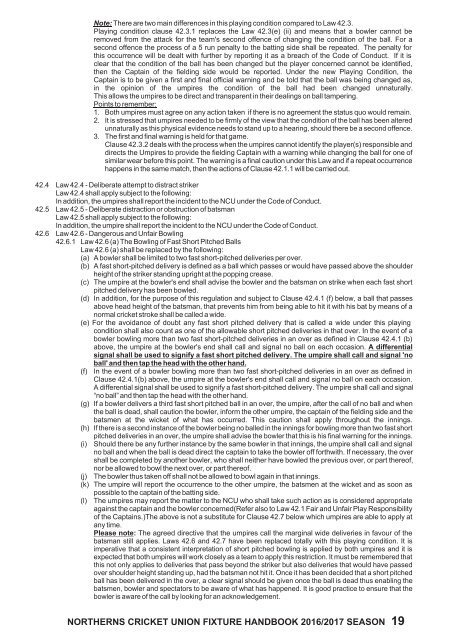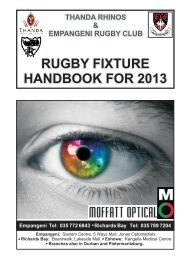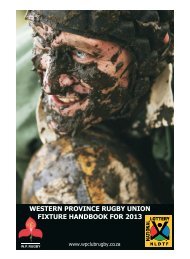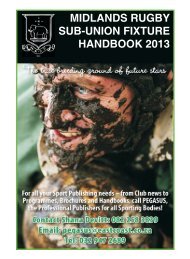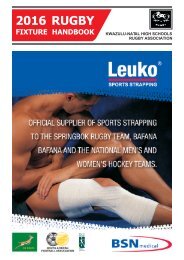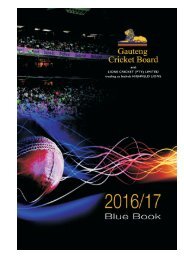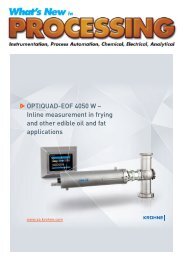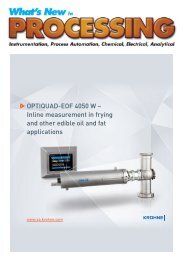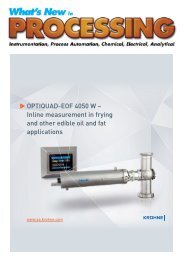Create successful ePaper yourself
Turn your PDF publications into a flip-book with our unique Google optimized e-Paper software.
Note: There are two main differences in this playing condition compared to Law 42.3.<br />
Playing condition clause 42.3.1 replaces the Law 42.3(e) (ii) and means that a bowler cannot be<br />
removed from the attack for the team's second offence of changing the condition of the ball. For a<br />
second offence the process of a 5 run penalty to the batting side shall be repeated. The penalty for<br />
this occurrence will be dealt with further by reporting it as a breach of the Code of Conduct. If it is<br />
clear that the condition of the ball has been changed but the player concerned cannot be identified,<br />
then the Captain of the fielding side would be reported. Under the new Playing Condition, the<br />
Captain is to be given a first and final official warning and be told that the ball was being changed as,<br />
in the opinion of the umpires the condition of the ball had been changed unnaturally.<br />
This allows the umpires to be direct and transparent in their dealings on ball tampering.<br />
Points to remember:<br />
1. Both umpires must agree on any action taken if there is no agreement the status quo would remain.<br />
2. It is stressed that umpires needed to be firmly of the view that the condition of the ball has been altered<br />
unnaturally as this physical evidence needs to stand up to a hearing, should there be a second offence.<br />
3. The first and final warning is held for that game.<br />
Clause 42.3.2 deals with the process when the umpires cannot identify the player(s) responsible and<br />
directs the Umpires to provide the fielding Captain with a warning while changing the ball for one of<br />
similar wear before this point. The warning is a final caution under this Law and if a repeat occurrence<br />
happens in the same match, then the actions of Clause 42.1.1 will be carried out.<br />
42.4 Law 42.4 - Deliberate attempt to distract striker<br />
Law 42.4 shall apply subject to the following:<br />
In addition, the umpires shall report the incident to the NCU under the Code of Conduct.<br />
42.5 Law 42.5 - Deliberate distraction or obstruction of batsman<br />
Law 42.5 shall apply subject to the following:<br />
In addition, the umpire shall report the incident to the NCU under the Code of Conduct.<br />
42.6 Law 42.6 - Dangerous and Unfair Bowling<br />
42.6.1 Law 42.6 (a) The Bowling of Fast Short Pitched Balls<br />
Law 42.6 (a) shall be replaced by the following:<br />
(a) A bowler shall be limited to two fast short-pitched deliveries per over.<br />
(b) A fast short-pitched delivery is defined as a ball which passes or would have passed above the shoulder<br />
height of the striker standing upright at the popping crease.<br />
(c) The umpire at the bowler's end shall advise the bowler and the batsman on strike when each fast short<br />
pitched delivery has been bowled.<br />
(d) In addition, for the purpose of this regulation and subject to Clause 42.4.1 (f) below, a ball that passes<br />
above head height of the batsman, that prevents him from being able to hit it with his bat by means of a<br />
normal cricket stroke shall be called a wide.<br />
(e) For the avoidance of doubt any fast short pitched delivery that is called a wide under this playing<br />
condition shall also count as one of the allowable short pitched deliveries in that over. In the event of a<br />
bowler bowling more than two fast short-pitched deliveries in an over as defined in Clause 42.4.1 (b)<br />
above, the umpire at the bowler's end shall call and signal no ball on each occasion. A differential<br />
signal shall be used to signify a fast short pitched delivery. The umpire shall call and signal 'no<br />
ball' and then tap the head with the other hand.<br />
(f) In the event of a bowler bowling more than two fast short-pitched deliveries in an over as defined in<br />
Clause 42.4.1(b) above, the umpire at the bowler's end shall call and signal no ball on each occasion.<br />
A differential signal shall be used to signify a fast short-pitched delivery. The umpire shall call and signal<br />
“no ball” and then tap the head with the other hand.<br />
(g) If a bowler delivers a third fast short pitched ball in an over, the umpire, after the call of no ball and when<br />
the ball is dead, shall caution the bowler, inform the other umpire, the captain of the fielding side and the<br />
batsmen at the wicket of what has occurred. This caution shall apply throughout the innings.<br />
(h) If there is a second instance of the bowler being no balled in the innings for bowling more than two fast short<br />
pitched deliveries in an over, the umpire shall advise the bowler that this is his final warning for the innings.<br />
(i) Should there be any further instance by the same bowler in that innings, the umpire shall call and signal<br />
no ball and when the ball is dead direct the captain to take the bowler off forthwith. If necessary, the over<br />
shall be completed by another bowler, who shall neither have bowled the previous over, or part thereof,<br />
nor be allowed to bowl the next over, or part thereof.<br />
(j) The bowler thus taken off shall not be allowed to bowl again in that innings.<br />
(k) The umpire will report the occurrence to the other umpire, the batsmen at the wicket and as soon as<br />
possible to the captain of the batting side.<br />
(l) The umpires may report the matter to the NCU who shall take such action as is considered appropriate<br />
against the captain and the bowler concerned(Refer also to Law 42.1 Fair and Unfair Play Responsibility<br />
of the Captains.)The above is not a substitute for Clause 42.7 below which umpires are able to apply at<br />
any time.<br />
Please note: The agreed directive that the umpires call the marginal wide deliveries in favour of the<br />
batsman still applies. Laws 42.6 and 42.7 have been replaced totally with this playing condition. It is<br />
imperative that a consistent interpretation of short pitched bowling is applied by both umpires and it is<br />
expected that both umpires will work closely as a team to apply this restriction. It must be remembered that<br />
this not only applies to deliveries that pass beyond the striker but also deliveries that would have passed<br />
over shoulder height standing up, had the batsman not hit it. Once it has been decided that a short pitched<br />
ball has been delivered in the over, a clear signal should be given once the ball is dead thus enabling the<br />
batsmen, bowler and spectators to be aware of what has happened. It is good practice to ensure that the<br />
bowler is aware of the call by looking for an acknowledgement.<br />
NORTHERNS CRICKET UNION FIXTURE HANDBOOK 2016/<strong>2017</strong> SEASON 19


